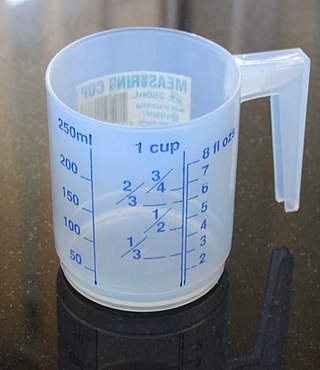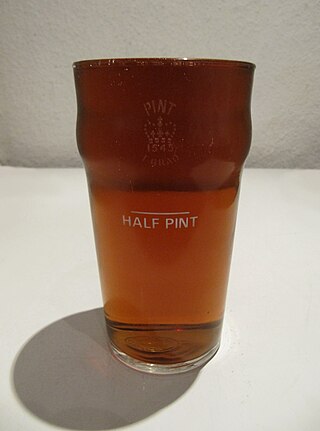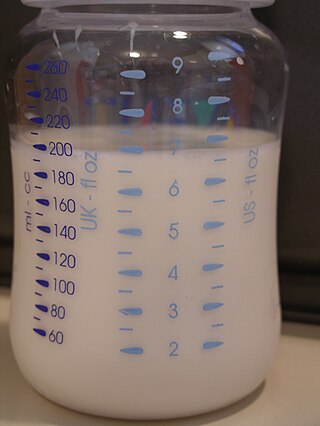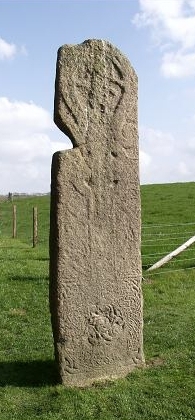Related Research Articles

The gallon is a unit of volume in British imperial units and United States customary units. Three different versions are in current use:

The imperial system of units, imperial system or imperial units is the system of units first defined in the British Weights and Measures Act 1824 and continued to be developed through a series of Weights and Measures Acts and amendments.

United States customary units form a system of measurement units commonly used in the United States and most U.S. territories, since being standardized and adopted in 1832. The United States customary system developed from English units that were in use in the British Empire before the U.S. became an independent country. The United Kingdom's system of measures evolved by 1824 to create the imperial system, which was officially adopted in 1826, changing the definitions of some of its units. Consequently, while many U.S. units are essentially similar to their imperial counterparts, there are noticeable differences between the systems.

Volume is a measure of regions in three-dimensional space. It is often quantified numerically using SI derived units or by various imperial or US customary units. The definition of length and height (cubed) is interrelated with volume. The volume of a container is generally understood to be the capacity of the container; i.e., the amount of fluid that the container could hold, rather than the amount of space the container itself displaces. By metonymy, the term "volume" sometimes is used to refer to the corresponding region.

In recipes, quantities of ingredients may be specified by mass, by volume, or by count.

The pint is a unit of volume or capacity in both the imperial and United States customary measurement systems. In both of those systems it is traditionally one eighth of a gallon. The British imperial pint is about 20% larger than the American pint because the two systems are defined differently. Almost all other countries have standardized on the metric system, so although some of them still also have traditional units called pints, the volume varies by regional custom.

The quart is a unit of volume equal to a quarter of a gallon. Three kinds of quarts are currently used: the liquid quart and dry quart of the US customary system and the imperial quart of the British imperial system. All are roughly equal to one liter. It is divided into two pints or four cups. Historically, the exact size of the quart has varied with the different values of gallons over time and in reference to different commodities.

A fluid ounce is a unit of volume typically used for measuring liquids. The British Imperial, the United States customary, and the United States food labeling fluid ounce are the three that are still in common use, although various definitions have been used throughout history.
English units were the units of measurement used in England up to 1826, which evolved as a combination of the Anglo-Saxon and Roman systems of units. Various standards have applied to English units at different times, in different places, and for different applications.

Scottish or Scots units of measurement are the weights and measures peculiar to Scotland which were nominally replaced by English units in 1685 but continued to be used in unofficial contexts until at least the late 18th century. The system was based on the ell, stone, and boll and firlot. This official system coexisted with local variants, especially for the measurement of land area.

The gill or teacup is a unit of measurement for volume equal to a quarter of a pint. It is no longer in common use, except in regard to the volume of alcoholic spirits measures.

Both the British imperial measurement system and United States customary systems of measurement derive from earlier English unit systems used prior to 1824 that were the result of a combination of the local Anglo-Saxon units inherited from Germanic tribes and Roman units.
Alcohol measurements are units of measurement for determining amounts of beverage alcohol.
The chopin was a Scottish measurement of volume, usually for fluids, that was in use from at least 1661, though possibly 15th century, until the mid 19th century. The measurement was derived from the French measure chopine an old and widespread unit of liquid capacity, first recorded in the 13th century. A chopin is equivalent to 0.848 litres.
The joug or Scots pint or Scottish pint was a Scottish unit of liquid volume measurement that was in use from at least 1661 – possibly as early as the 15th century – until the early 19th century, approximately equivalent to 1696 mL or roughly three imperial pints.
The Scots gallon was a unit of liquid volume measurement that was in use in Scotland from at least 1661 – and possibly as early as the 15th century – until the late 19th century. It was approximately equivalent to 13.568 litres, or very roughly three times larger than the Imperial gallon that was adopted in 1824. A Scots gallon could be subdivided into eight Jougs, or into sixteen chopins.

The firlot was a dry measure used in Scotland. For centuries it was the primary measure for all grains sold in the country. In the Scottish system a firlot was equal to 4 pecks, and the boll was equal to 4 firlots.
Capacities of brewery casks were formerly measured and standardised according to a specific system of English units. The system was originally based on the ale gallon of 282 cubic inches. In United Kingdom and its colonies, with the adoption of the imperial system in 1824, the units were redefined in terms of the slightly smaller imperial gallon. The older units continued in use in the United States.
A number of different units of measurement were historically used in Cyprus to measure quantities like length, mass, area and capacity. Before the Metric system, the Imperial system was used. In between 1986-1988, metric system was adopted in Cyprus.
A number of units of measurement were used in South Africa to measure quantities like length, mass, capacity, etc. The Imperial system of measurements was made standard in 1922 and the metric system was adopted in 1961.
References
- ↑ Alexander Huntar (1624). A treatise, of vveights, mets and measures of Scotland. With their quantities, and true foundation, and sundrie profitable observations, arising vpon everie one of them. Together with the art of metting, measuring & computing all sort of land with diverse tables. ISBN 90-221-0671-3.
- ↑
- The Concise Scots Dictionary. Aberdeen University Press. 1985. ISBN 0-08-028491-4.